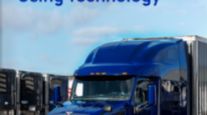Fleets Seek New Technology to Aid Safety, Savings, Fuel
This story appears in the Nov. 29 print edition of Transport Topics.
Managers of large fleets want to buy improved equipment and advanced technologies despite the recent recession but are insisting upon payback periods of four years or less, according to a recent survey.
A report from consulting firm Frost & Sullivan examined the preferences of 101 managers of large U.S. for-hire and private fleets and found them very receptive to technologies and systems that can lower operating costs through safety and fuel-efficiency improvements.
“We see truck fleets choosing higher priced technologies if they can reduce the cost of ownership for equipment,” said Sandeep Kar, a Toronto-based manager for Frost & Sullivan and the report’s author. He added that return on investment is a key consideration.
“For more expensive systems, like hybrids and other powertrain technologies, there is a three- to four-year horizon. But for safety and telematics systems they’re looking at six to 12 months ROI,” Kar said. He said the survey focused on large fleets of Class 6-8 trucks, as those companies would probably have greater budgets for advanced systems.
Concerns about rising fuel costs drove many of the choices, Kar said.
“These managers changed after 2008, regarding diesel and oil prices. They know that when the economy recovers, the price of fuel will return to $5 a gallon and then go higher,” Kar said.
Seventy-eight percent of those surveyed by F&S said advanced engine oil is a very important or somewhat important powertrain technology.
In terms of communications, more than 70% of the managers found four technologies to be very or somewhat important: onboard telematics, safety intervention systems, remote diagnostics and prognostics, and back-office automation.
Among the systems commonly used now are tire-pressure monitoring, 43%; disc or large drum brakes, 39%; and trailer tire inflation systems, 39%, Frost & Sullivan said.
The report is largely consistent with efforts by American Trucking Associations’ Technology & Maintenance Council, which operates a Future Truck Committee.
“We’ve talked about this sort of thing since 1985,” said committee Chairman John Sullivan, who is also the director of maintenance for Reliable Carriers, Canton, Mich.
“We want technologies that will provide increased productivity and efficiency, as long as you also get reliability, durability and maintainability,” he said.
Sullivan said his committee is investigating condition-based maintenance in conjunction with the Army. The goal is to have real-time access to the condition of truck parts and systems.
Kar said the managers with whom he spoke would happily pay $12 a month per truck for prognostic systems that assess parts and evaluate their life spans.
“The problem is that they don’t exist now,” he said, but Kar and Sullivan agreed such a system would be warmly received.
Kar said he thinks the annual survey will help keep original equipment manufacturers in touch with their customers’ needs.
“There are too many technologies chasing too few investment dollars now. OEMs need to know and understand what their customers want,” Kar said.
Truckload carrier Maverick USA has adopted a number of systems mentioned in the report, said Brent Hilton, Maverick’s director of maintenance and vice chairman of the TMC committee.
Battery-based auxiliary power units, tire-pressure monitoring and roll-stability avoidance have all been among the North Little Rock, Ark., carrier’s purchases. Hilton said the roll-stability systems cut Maverick’s rollover rate per million miles driven by more than 50%.
As for APUs, Hilton said Maverick went the electric route rather than using a diesel-fired system because of concerns about fuel prices and environmental regulations that could move from the tractor’s main engine to an APU engine.
While Maverick managers evaluate a lot of potential systems, Hilton said the company never forgets about ROI factors.
“We mainly have a 3.5-year trade cycle on tractors, so a four-year cycle wouldn’t work for us. We look at a 12-month return,” he said.
One technology that might remain indefinitely in the future is a hybrid powertrain for a heavy-duty linehaul tractor. Kar said the managers are curious about it, but so far, hybrids seem to work best for medium-duty vehicles or Class 8 refuse trucks that use hydraulic hybrids.
At ATA’s Management Conference & Exhibition last month in Phoenix, Martin Daum, CEO of Daimler Trucks North America, said a heavy-duty linehaul hybrid won’t come about in his lifetime because of limitations in battery technology. However, Daum did say that economically capturing and using waste heat from heavy-duty engines is one of the industry’s great engineering challenges and opportunities.




